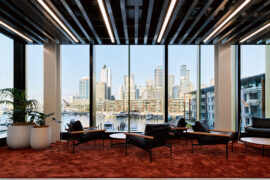With the Productivity Commission’s final report on Intellectual Property Arrangements due to be handed to Government later this month, the discussion on copyright protection for designers has reached a crescendo.
September 22nd, 2016
Not too long ago Australian furniture designer Jon Goulder made his Instagram followers aware an online retailer was selling copies of his Glissando Credenza. While the replica’s poor detailing and overall shoddy quality was enough to make me literally gasp out loud, it was the use of Jon’s name in the entry’s title that made me feel true outrage. By brazenly attaching ‘Jon Goulder’ to this rip-off, the suggestion is the designer himself endorses it. Now, I bet my right arm he did no such thing. No designer would condone the theft of their intellectual property, which basically amounts to having their hard work, skill and expertise completely undermined, exploited and disrespected.
The real vs fake debate is a long simmering one that appears to have reached boiling point nationwide. In light of the Productivity Commission’s release of its draft report on Intellectual Property Arrangements in late April – everybody (and not just the industry) is talking about it. And so we should be. It’s time something was done to stop Australia’s rampant replica trade that robs designers of due royalties and threatens to diminish innovation in Australian design.
Anticipation surrounding the release of the final report to be handed to the Australian Government later this month has certainly brought us to this (boiling) point. However the real catalyst is perhaps the UK’s implementation of new copyright laws earlier this year that makes it a criminal offence to make or import new furniture copies. While Dezeen reports the future of these laws may be uncertain following the Brexit vote, as they now stand, anyone committing such an offence will face penalties of up to 10 years jail and fines of up to £50,000. The new copyright laws also protect British industrial designers for 70 years after the death of the creator, placing them in line with the EU.
It’s interesting to note the degree to which the British courts deemed the threat of replicas to the country’s creative industries. So much so, laws originally slated for 2020 were brought forward with what can only be described as a sense of urgency in order to curb a rapidly escalating ‘copy culture’. So what is it we’re not getting in Australia?
This past week’s episode of Q&A on the ABC was instrumental in bringing what has long been a hot industry topic into the mainstream. When singer-songwriter Josh Pyke asked via video link ‘Are you aware of the importance of copyright and the attack on [the] creator’s rights?’ it gave two of the panelists, Magda Szubanski and Jimmy Barnes, the opportunity to voice their own views and weigh in on the subject.
Szubanski has recently released her first book and was also quick to point out the issue of copyright doesn’t only pertain to creative industries. As she explains, “It’s medical textbooks, [it’s] anything that you write or anyone in your family writes. If you write your family history and it ends up in a library and if I was an unscrupulous producer, in 15 years I could go and take your family history, make a film, not pay you a cent, not consult you…” It seems incredible that any governing body would deem a period of 15 years from date of publication to be fair copyright protection for a writer.
In regards to the music industry, Barnes was succinct in voicing his concerns for its sustainability and the lack of nurturing for new talent should the Productivity Commission’s draft report be upheld. As he sees it: “The recommendations are eroding and undermining the rights of a creative person”.
What particularly resonated with me during the Q&A discussion was the emphasis placed on the creator – a focus surprisingly often lacking in conversations surrounding industrial design (although Joe Aston’s delicious article in the Australian Financial Review certainly makes sure this point is front and centre). Consumer protection is an important issue and it’s raised by the always excellent Ray Edgar recently in The Age.
However, we currently reside in a market that encourages ‘substitutability’ to the detriment of the creator’s rights. This argument advocates the idea that consumers have a right to a cheaper version (the copy) of a more expensive item (the original). So, accordingly, if I can’t afford the new season Prada skirt I really, really want, I have the right to buy a much cheaper knock-off that looks (almost) like the one on the catwalk. But the thing is, while I may have snagged a bargain (supposedly), the original’s designer has lost out. They’re the one for whom product development is a significant risk and investment, and when copycats come along they’re the one who misses out on any sort of fair return.
Substitutability is something the Authentic Design Alliance (ADA) strongly disagrees with and in responding to the Productivity Commission’s draft report, ADA Director Anne-Maree Sargeant addresses the issue. “If you have $200 for a chair – find a $200 chair. Not a $200 copy of an original design [that’s] destined for landfill in two or so years,” she says. “The perception is that designer furniture is expensive… and good design doesn’t necessarily have to be expensive.”
In her new role as ADA Director, Sargeant has repositioned the advocacy group as an independent members-based education platform. She’s worked tirelessly over the past few months lobbying for Australian copyright laws to fall in line with the newly implemented UK ones. Part of this petitioning process involved the organisation of a formidable team of industry heavyweights to present submissions at the public hearings for the inquiry into Intellectual Property Arrangements. Held in late June in both Sydney and Canberra, the ADA’s ‘dream team’ included Sydney-based designers Adam Goodrum and Tom Fereday, Canberra-based designer Tom Skeehan, Cult founder and director Richard Munao, and owner of Top3 By Design Terri Winter.
I was fortunate to attend both public hearings and wasn’t surprised by the intelligence, dynamism and passion of these speakers. As representatives of the design industry they raised pertinent issues, challenged existing norms and championed the rights of the creator.
For example, Skeehan’s major concern with Australia’s current Intellectual Property laws is the lack of a grace period to protect new designs while they are being developed. “The UK model allows designers a two-year grace period for product development and industry feedback,” he explains. “After this period, the designer can choose to register their design… but in Australia, I have to register my design before any person from the public has seen it.” The problem here is that for Skeehan to resolve his design to a point where it’s ready for IP registration, the public needs to see it so that he can take on board their necessary feedback in order to resolve his design to a point where it’s ready for IP registration.
It’s inhibitive, not to mention dizzying in its logic. And unfortunately what it means for Australia’s design industry is that many designers – especially young designers – will consider relocating oversees to countries that will support best practice. The reality of the situation is that we may be left without an onshore industry.
I was impressed by the two Commissioners’ reactions to these submissions and can honestly say they appeared genuinely engaged, interested and concerned. They asked informed questions that sometimes interrogated, often queried and on a couple of occasions played Devil’s advocate. Yet I couldn’t help but walk away from the final hearing with a sense that an understanding of why replicas are wrong is still a way off.
It might have something to do with the word itself – ‘replica’ is so much more palatable than ‘copy’, ‘fake’ or ‘rip-off’. But it is what it is, no matter how you choose to sugarcoat it. Perhaps we should start substituting the word ‘replica’ with ‘counterfeit’. The connotations are completely different and the latter immediately raises issues of illegality, conjuring negativity and an instant distaste for anything not ‘real’. That copy of Goulder’s Glissando Credenza is counterfeit. It is an imposter – an inferior product able to be pumped out, so the retailer boasts, at the ridiculous rate of 1000 units per month. The real deal takes five weeks to manufacture, it is handmade; a superior study in high-end craftsmanship and well worth its asking price. Goulder’s design will last and become an heirloom that only increases in value – lucky if the counterfeit manages to stay in one piece for more than a couple of months.
Don’t be fooled into believing a ‘replica’ is of equal quality, because it’s not. And while this may require a shift in thinking, let’s remember how New Zealand-based lighting designer David Trubridge took the retailers selling replicas of his work in Australia to court and won. In a talk hosted by the ADA in June of this year, Trubridge publicly destroyed the rip-offs of his designs by dramatically stamping on them and literally crushing them. There is no more potently symbolic image in the current war on replicas.
Pictured – Tom Skeehan Hup Hup Chair, and Tom Fereday Wes Lounge.
INDESIGN is on instagram
Follow @indesignlive
A searchable and comprehensive guide for specifying leading products and their suppliers
Keep up to date with the latest and greatest from our industry BFF's!

London-based design duo Raw Edges have joined forces with Established & Sons and Tongue & Groove to introduce Wall to Wall – a hand-stained, “living collection” that transforms parquet flooring into a canvas of colour, pattern, and possibility.

The undeniable thread connecting Herman Miller and Knoll’s design legacies across the decades now finds its profound physical embodiment at MillerKnoll’s new Design Yard Archives.

Khai Liew has literally designed an amazing life and career. He is the epitome of the quiet achiever who has reached the ultimate in his profession as an object maker and designer.

Catch up with some of our industry’s top talents at this year’s Saturday Indesign speaker series.

The Studio* Collaborative’s Melinda Huuk sums it up perfectly when she says, we can rationalise beauty to ourselves but it “needs to be underpinned by purpose and responsibility”. She highlights the Fleur Sofa by King for its responsible manufacture – a quality that takes its beauty beyond skin-deep.
The internet never sleeps! Here's the stuff you might have missed

Warren and Mahoney’s design for Beca’s Auckland headquarters turns the mechanics of engineering into poetry, rethinking how workplace design can reveal its own systems.

The Australian Institute of Architects has unveiled 43 projects representing the pinnacle of contemporary design, with winners addressing housing, climate and affordability crises through innovative solutions.